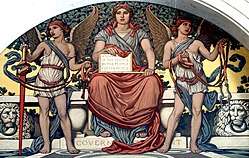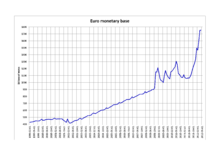Monetary base
| Public finance |
|---|
 |
|
Reform |

In economics, the monetary base (also base money, money base, high-powered money, reserve money, outside money, central bank money or, in the UK, narrow money) in a country is defined as the portion of a commercial bank's reserves that consist of the commercial bank's accounts with its central bank[1] plus the total currency circulating in the public, plus the currency, also known as vault cash, that is physically held in the bank's vault.[2]
The monetary base should not be confused with the money supply which consists of the total currency circulating in the public plus the non-bank deposits with commercial banks.
Management

Open market operations are monetary policy tools which directly expand or contract the monetary base.
The monetary base and monetary policy are typically controlled by the same national institution, usually either the finance ministry or the central bank. These institutions change the monetary base through open market transactions: the buying and selling of government bonds. Typically, they can also influence banking activities by manipulating interest rates and setting reserve requirements (how much money banks must keep on hand instead of loaning out to borrowers).
The monetary base (MB) has traditionally been considered high-powered because its increase will typically result in a much larger increase in the supply of demand deposits through banks' loan-making; a ratio called the money multiplier.[3] However, for those that do not agree with the theory of the money multiplier, the monetary base can be thought of as high-powered because of the fiscal multiplier instead.
United States
As of August 2018, the monetary base in the United States was USD $3,584,502,000,000[4]
See also
References
- ↑ See, e.g., U.S. Federal Reserve System regulation at 12 C.F.R. section 204.5(a)(1)(i).
- ↑ See, e.g., U.S. Federal Reserve System regulations at 12 C.F.R. section 204.5(a)(1) and 12 C.F.R. section 204.2.
- ↑ Mankiw, N. Gregory (2002), "Chapter 18: Money Supply and Money Demand", Macroeconomics (5th ed.), Worth, pp. 482–489
- ↑ "Monetary Base; Total". Economic Research – Federal Reserve Bank of St. Louis.
External links
- Brunner, Karl (1987). "High-powered money and the monetary base". In Newman, Peter K.; Eatwell, John; Palgrave, Robert Harry Inglis; Milgate, Murray. The New Palgrave Dictionary of Economics. New York: Macmillan. doi:10.1057/9780230226203.2726. ISBN 0-935859-10-1. Retrieved 8 February 2011.
- Goodhart, Charles (1987). "Monetary base". In Newman, Peter K.; Eatwell, John; Palgrave, Robert Harry Inglis; Milgate, Murray. The New Palgrave Dictionary of Economics. New York: Macmillan. doi:10.1057/9780230226203.3102. ISBN 0-935859-10-1. Retrieved 8 February 2011.
- Cagan, Phillip (1965). "High-Powered Money". Determinants and Effects of Changes in the Stock of Money, 1875-1960 (PDF). Cambridge, Massachusetts: National Bureau of Economic Research. pp. 45–117. ISBN 0-87014-097-3. Retrieved 8 February 2011.
- Aggregate Reserves Of Depository Institutions And The Monetary Base (H.3)